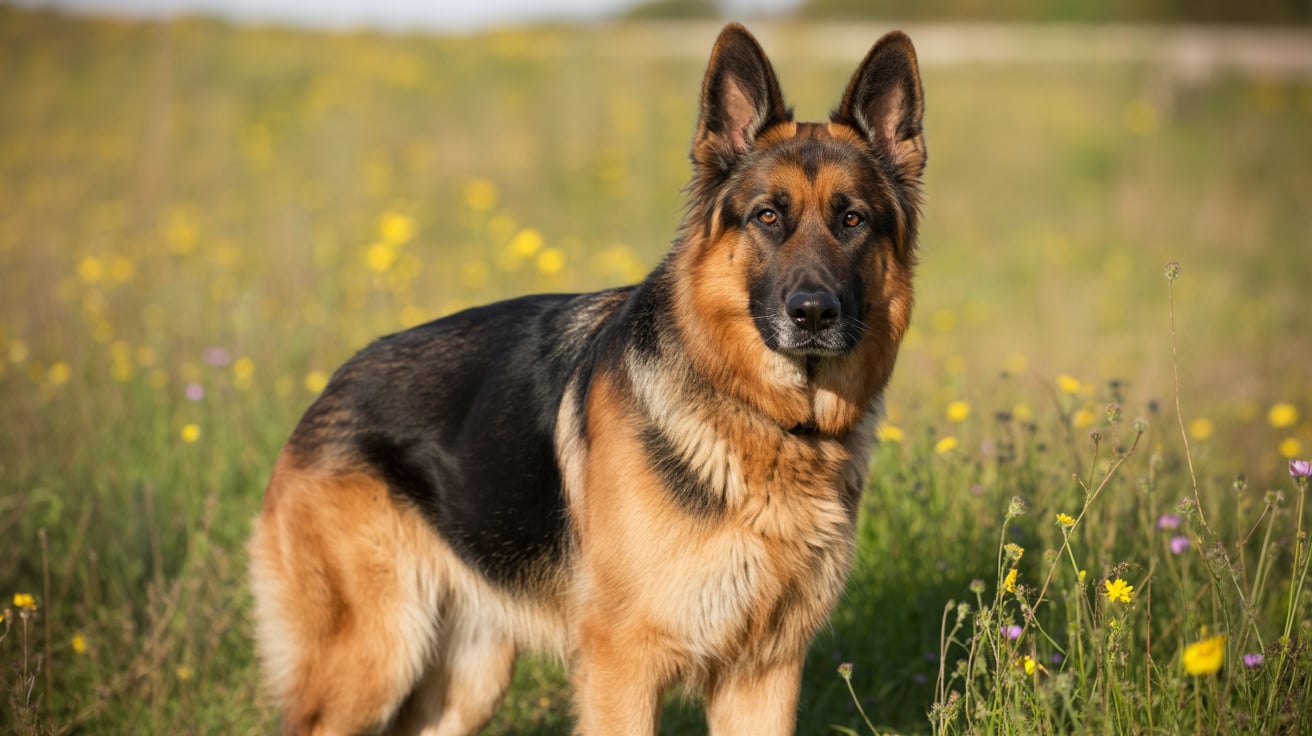7 Tips to Manage Seasonal Allergies in Dogs
If you’ve noticed your dog scratching more than usual when spring blooms or fall leaves start falling, you’re not imagining things.
Seasonal allergies in dogs are incredibly common, affecting an estimated 10-15% of all dogs—and that number seems to be rising every year.
Just like their human companions, dogs can suffer from environmental allergens that make certain times of year absolutely miserable.
Picture this: Your normally playful pup is constantly scratching, their eyes are red and watery, they’re obsessively licking their paws until they’re stained brown, and they seem generally uncomfortable in their own skin.
As a loving pet parent, watching your dog suffer through allergy season can be heartbreaking. You want to help, but you’re not sure where to start or what actually works.
The good news? While you can’t eliminate seasonal allergens entirely, you absolutely can manage your dog’s symptoms and dramatically improve their quality of life during allergy season.
Unlike food allergies, which require elimination diets, or flea allergies, which need pest control, seasonal allergies respond well to a combination of environmental management, grooming practices, and supportive care.
Seasonal allergies—also called atopic dermatitis or environmental allergies—occur when your dog’s immune system overreacts to normally harmless substances like pollen, grass, mold spores, or dust mites.
These allergens can be inhaled, but dogs more commonly absorb them through their skin, which is why itching and skin issues are the primary symptoms rather than sneezing like in humans.
Common signs your dog has seasonal allergies:
- Excessive scratching, especially face, paws, ears, and belly
- Red, inflamed skin or hot spots
- Obsessive paw licking or chewing (often leaving brown staining)
- Frequent ear infections or head shaking
- Watery, red eyes or eye discharge
- Rubbing face on carpet or furniture
- Hair loss from constant scratching
- Recurrent skin infections
In this comprehensive guide, we’ll walk through seven practical, veterinarian-approved tips to help manage your dog’s seasonal allergies.
These aren’t expensive, complicated treatments—they’re simple strategies you can implement at home starting today to bring your furry friend relief and comfort during their toughest seasons.
Quick Overview: 7 Essential Allergy Management Tips
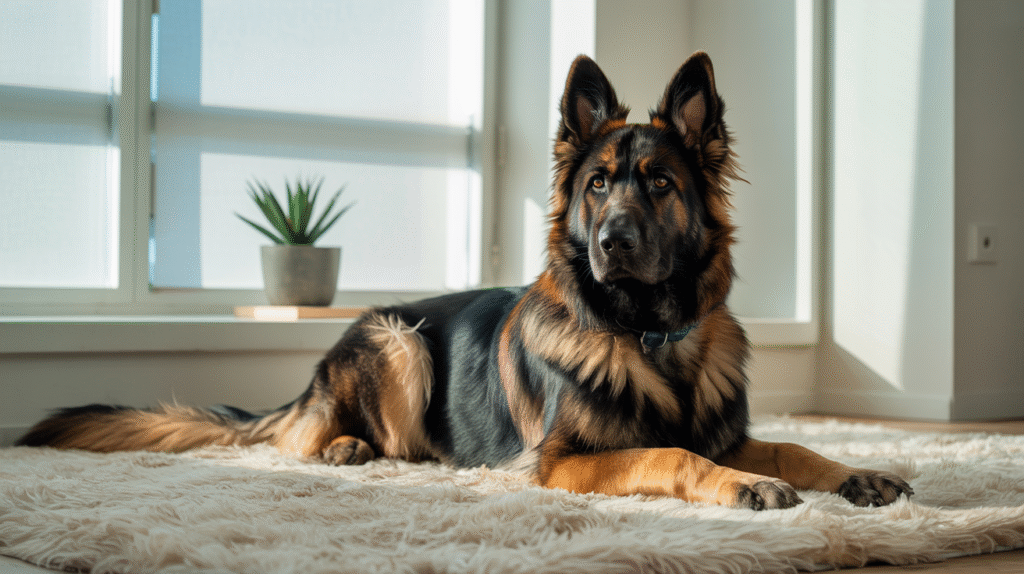
Before we dive deep into each strategy, here’s your quick reference guide for managing seasonal allergies in dogs:
- Wipe paws and coat after outdoor walks – Remove allergens before they spread throughout your home
- Bathe weekly with hypoallergenic shampoo – Wash away pollen and soothe irritated skin
- Use an air purifier indoors – Filter out airborne allergens in your home
- Minimize grass and pollen exposure – Time walks strategically and create safe zones
- Supplement with omega-3 fatty acids – Support skin barrier function from the inside
- Monitor and treat hot spots promptly – Prevent minor irritation from becoming infected
- Work with your vet on safe medications – Find the right allergy relief for your dog’s specific needs
Now let’s explore each tip in detail so you can create a comprehensive allergy management plan for your pup.
Tip 1: Wipe Paws and Coat After Outdoor Walks
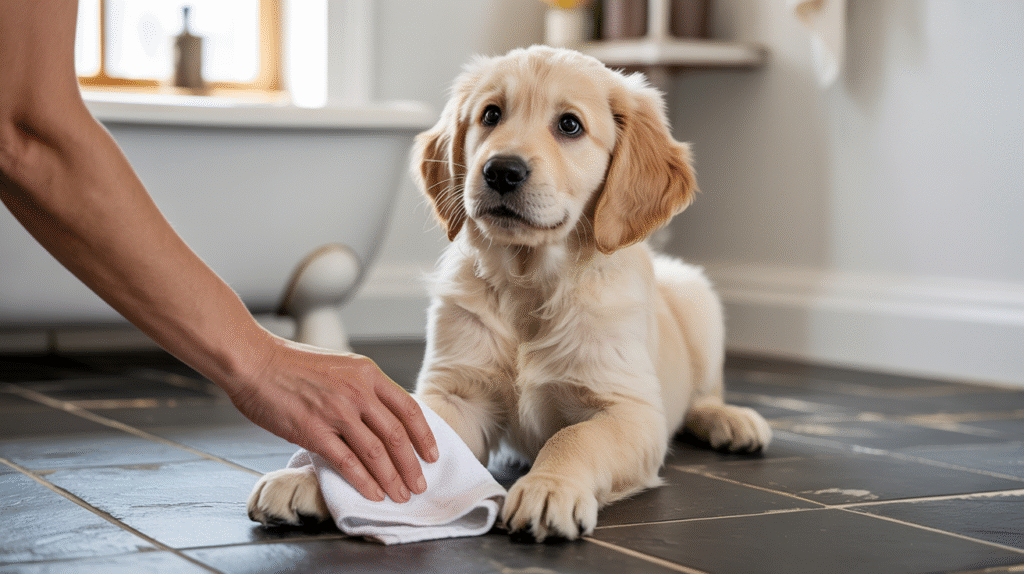
Why This Works: Your dog is essentially a walking allergen magnet. Every time they go outside, pollen, grass particles, mold spores, and other allergens cling to their coat, collect between their paw pads, and stick to their belly.
When they come inside, they spread these allergens throughout your home—on furniture, bedding, and carpets—creating constant exposure. A simple wipe-down after walks can remove up to 85% of these allergens before they cause problems.
Step-by-Step Instructions:
- Set up a “decontamination station” near your most-used door. Keep supplies in a basket or bin: pet-safe wipes, a damp towel, and a dry towel.
- Start with the paws. Before your dog enters the house, wipe each paw thoroughly—top, bottom, and between the pads where allergens hide. Pay special attention to the webbing between toes.
- Wipe the face and muzzle. Many dogs rub their faces in grass or dirt. Gently wipe around the eyes, nose, and mouth area.
- Clean the belly and legs. These areas drag through grass and pick up the most pollen. Use a damp cloth to wipe the entire undercarriage, inner legs, and lower chest.
- Don’t forget the ears. Wipe the outer ear flaps, especially on floppy-eared breeds where moisture and allergens can get trapped.
- Finish with a quick coat wipe. Run a damp cloth over their back and sides to catch any surface pollen.
- Wash or dispose of wipes properly. Don’t reuse dirty wipes, as you’ll just redistribute allergens.
Recommended Products:
- Hypoallergenic pet wipes: Look for fragrance-free, alcohol-free options like Earthbath Hypo-Allergenic Grooming Wipes or Burt’s Bees Dander Reducing Wipes
- Microfiber towels: More effective at trapping particles than regular towels
- Paw plunger or paw washer: For dogs who tolerate it, these devices deep-clean between paw pads
- Allergen-removing sprays: Products like Allersearch Pet+ can be sprayed on coats to neutralize allergens
How Often:
- After every outdoor excursion during peak allergy season (spring and fall)
- Minimum: once daily during high pollen count days
- Extra attention after walks in grassy areas, parks, or wooded trails
Results to Expect: Most pet parents notice reduced scratching within 3-5 days of consistent wiping. You may also notice your dog’s eyes look clearer and they’re less likely to develop ear issues. This simple habit prevents the constant re-exposure that makes allergies worse.
Troubleshooting:
“My dog won’t let me wipe their paws.” Start slowly with positive reinforcement. Touch one paw briefly, give a treat. Build up to wiping one paw, treat, then two paws, and so on. Make it part of your routine so your dog expects it. Some dogs respond better to a quick rinse in a bucket than wiping.
“The wiping seems to irritate their skin more.” You may be using wipes with irritating ingredients. Switch to plain warm water on a soft cloth, or look for truly hypoallergenic wipes without added fragrances or cleaning agents.
Tip 2: Bathe Weekly With Hypoallergenic Dog Shampoo
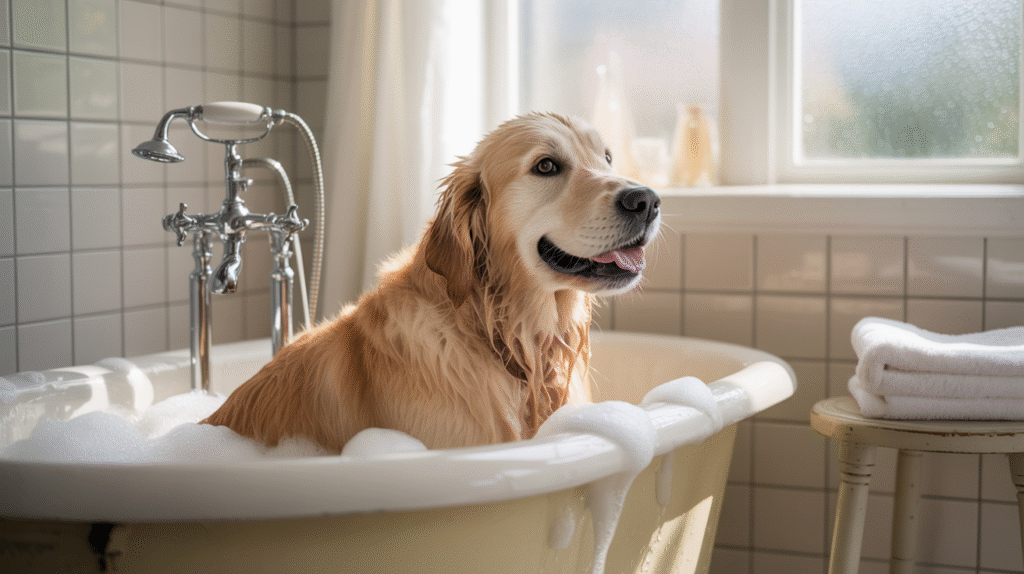
Why This Works: Regular bathing is one of the most effective ways to manage environmental allergies in dogs.
Bathing physically removes allergens from your dog’s skin and coat, provides immediate itch relief, and can reduce the inflammatory response.
While many people worry that frequent bathing will dry out their dog’s skin, using the right products actually helps maintain skin health and barrier function.
Step-by-Step Instructions:
- Choose the right shampoo. Look for hypoallergenic, soap-free formulas designed for sensitive skin. Medicated shampoos containing oatmeal, aloe, or hydrocortisone can provide extra relief.
- Brush before bathing. Remove loose hair and tangles first. This helps the shampoo reach the skin more effectively.
- Use lukewarm water. Hot water can further irritate inflamed skin. Aim for comfortably warm, not hot.
- Wet thoroughly. Make sure water reaches the skin, not just the topcoat. This is especially important for thick-coated breeds.
- Apply shampoo and let it sit. Lather the shampoo all over, paying special attention to problem areas (paws, belly, armpits, groin). Let medicated shampoos sit for 5-10 minutes for maximum benefit—read the product instructions.
- Massage gently. Use your fingertips (not nails) to massage the shampoo into the skin. This helps remove allergens and provides soothing contact.
- Rinse completely. This is crucial! Shampoo residue can cause irritation. Rinse until the water runs completely clear, then rinse one more time.
- Consider a soothing rinse. Some veterinarians recommend a diluted apple cider vinegar rinse (1 part vinegar to 3 parts water) or a colloidal oatmeal leave-in conditioner to restore skin pH and provide extra relief.
- Dry thoroughly. Pay attention to skin folds, between toes, and under ears where moisture can lead to secondary infections. Use a towel or low-heat dryer.
Recommended Products:
For Mild Allergies:
- Earthbath Oatmeal & Aloe Shampoo
- Burt’s Bees Hypoallergenic Shampoo
- Vet’s Best Allergy Itch Relief Shampoo
For Moderate to Severe Allergies:
- Douxo S3 Calm Shampoo (veterinary-grade)
- Malaseb Medicated Shampoo (antifungal/antibacterial)
- Veterinary Formula Clinical Care Hot Spot & Itch Relief
- Virbac Epi-Soothe Shampoo
Prescription Options (from your vet):
- Chlorhexidine-based shampoos for secondary infections
- Ketoconazole shampoos for yeast issues
- Phytosphingosine/salicylic acid combinations
Bathing Frequency:
- During allergy season: Once weekly, or up to twice weekly for severe allergies (with vet approval)
- Mild allergy seasons: Every 10-14 days
- Between seasons: Monthly or as needed
Important note: Frequent bathing is only beneficial when using gentle, moisturizing products. Regular human shampoo or harsh dog shampoos can damage the skin barrier.
Results to Expect: Many dogs show immediate improvement after a proper bath—reduced scratching, less redness, and better comfort.
With consistent weekly bathing during allergy season, you should see cumulative improvement in skin condition, fewer hot spots, and reduced need for medications.
Troubleshooting:
“My dog hates baths and it’s extremely stressful.” Try these strategies:
- Use a shower attachment with gentle pressure rather than running water
- Put a non-slip mat in the tub for security
- Give high-value treats throughout the bath
- Start with very short “baths” (just feet washing) and gradually increase
- Consider professional grooming where staff are experienced with anxious dogs
- For extreme cases, discuss sedation options with your vet for bath time
“Bathing seems to make the itching worse.” This usually means:
- You’re not rinsing thoroughly enough (shampoo residue is irritating)
- The water is too hot
- The shampoo contains irritating fragrances or ingredients
- Your dog has a skin infection that needs veterinary treatment first
“I don’t have time for weekly baths.” Consider:
- Using a professional groomer every 2 weeks
- Doing a “spot bath” of just the most affected areas (paws, belly, face)
- Using dry shampoo or waterless bath products between full baths
- Making bath time faster with better preparation and setup
Tip 3: Use an Air Purifier for Indoor Spaces
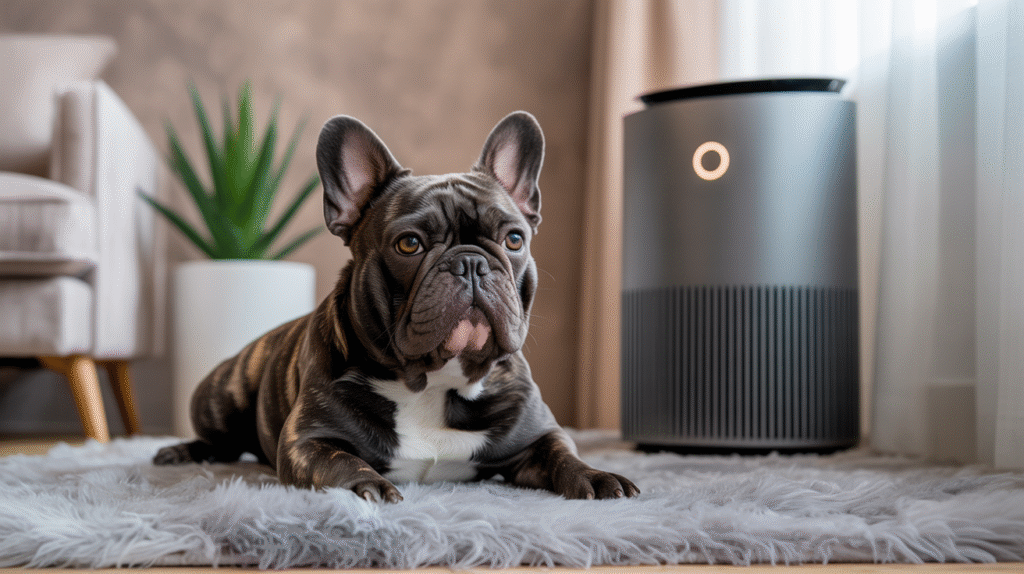
Why This Works: Your home should be your dog’s safe haven from outdoor allergens, but reality is more complicated.
Allergens get tracked inside on shoes, clothes, and pet fur. Indoor allergens like dust mites, mold spores, and even human dander can also trigger reactions.
A quality air purifier with a HEPA filter can remove up to 99.97% of airborne particles, significantly reducing your dog’s overall allergen exposure and providing relief, especially during sleep hours.
Step-by-Step Implementation:
- Choose the right purifier. Look for:
- True HEPA filter (not “HEPA-type” or “HEPA-like”)
- Appropriate room size coverage (match to your space)
- CADR rating (Clean Air Delivery Rate) of at least 100+ for small rooms, 300+ for large rooms
- Low noise level if placing in bedroom
- Activated carbon filter for odors (bonus for pet households)
- Place strategically. Position your air purifier:
- In the room where your dog spends most time (often living room or bedroom)
- At least 6-12 inches away from walls for proper air circulation
- Away from furniture that might block airflow
- Not directly next to your dog’s bed (the airflow can be irritating)
- Run continuously. Air purifiers work best when run 24/7, especially during high pollen seasons. Most modern units are energy-efficient.
- Maintain filters properly.
- Check pre-filters monthly and vacuum or wash them
- Replace HEPA filters according to manufacturer recommendations (typically every 6-12 months)
- Replace activated carbon filters every 3-6 months
- Set calendar reminders for maintenance
- Use in conjunction with other strategies. Air purifiers work best as part of a comprehensive approach, not as a standalone solution.
Recommended Products:
Budget-Friendly Options ($50-$150):
- Levoit Core 300
- GermGuardian AC4825
- Honeywell HPA100
Mid-Range Options ($150-$300):
- Coway AP-1512HH Mighty
- Blueair Blue Pure 211+
- Winix 5500-2
Premium Options ($300+):
- Dyson Pure Cool TP04
- Rabbit Air MinusA2
- IQAir HealthPro Plus
What to Look For:
- True HEPA filtration (H13 grade preferred)
- Multiple fan speeds
- Filter replacement indicators
- Energy Star certified
- Quiet operation (under 50 dB on low)
- Pet-specific models with odor control
Expected Results: You won’t see overnight miracles, but within 2-3 weeks of consistent use, many pet parents notice:
- Reduced nighttime scratching and better sleep for their dog
- Less eye discharge and redness
- Fewer respiratory symptoms (if present)
- General improvement in comfort levels
- Cleaner-smelling home environment
Additional Indoor Air Quality Tips:
- Vacuum frequently with a HEPA-filtered vacuum (2-3 times weekly during allergy season)
- Wash dog bedding weekly in hot water
- Use allergen-reducing sprays on carpets and upholstery
- Keep windows closed during high pollen count days
- Change HVAC filters monthly during allergy season
- Remove carpets if possible (hard floors are easier to keep allergen-free)
- Keep humidity between 30-50% to prevent mold and dust mite growth
Troubleshooting:
“I don’t notice any difference after using an air purifier.” Check:
- Is it sized appropriately for your room? (Too small won’t be effective)
- Are you running it continuously?
- When did you last replace the filters?
- Is your dog’s allergy primarily skin-contact rather than airborne?
- Are other allergen sources being addressed (outdoor tracking, bedding, etc.)?
“The air purifier is too noisy.”
- Try running it on a lower speed, especially at night
- Place it further from sleeping areas
- Look for models specifically rated for quiet operation
- Some noise (white noise) can actually help dogs sleep better
Tip 4: Minimize Grass and Pollen Exposure

Why This Works: The most effective way to manage allergies is to reduce exposure to triggers. For many dogs, grass pollen is the primary culprit, especially in spring and early summer.
By being strategic about when, where, and how long your dog spends outdoors, you can dramatically reduce their allergen load without sacrificing exercise and mental stimulation.
Strategic Outdoor Management:
Timing Your Walks:
- Avoid early morning walks. Pollen counts are typically highest between 5 AM and 10 AM when plants release pollen.
- Walk in late afternoon or evening. Pollen counts drop in the late afternoon and evening hours.
- Skip outdoor time after mowing. Lawn mowing stirs up massive amounts of grass pollen and mold spores. Wait at least 24 hours after your lawn is mowed before allowing your dog outside.
- Check daily pollen counts. Use weather apps or websites like Pollen.com to plan outdoor activities on low-pollen days.
- After rain is ideal. Rain washes pollen from the air. Post-rain walks are often the best time for allergic dogs.
Choosing Better Walking Locations:
- Stick to paved paths instead of grass trails when possible. Sidewalks, bike paths, and paved park paths expose your dog to less pollen.
- Avoid overgrown areas. Weeds, wildflowers, and tall grass are pollen factories. Stick to maintained areas.
- Beach or water walks. If you have access, beaches and waterside paths typically have lower pollen counts.
- Urban walking. Sometimes city sidewalks are better than suburban parks during high pollen seasons.
Yard Management:
- Create a pollen-free potty zone. If possible, dedicate a small area of your yard for quick potty breaks:
- Use gravel, mulch, or artificial turf instead of grass
- Keep it small (just 10×10 feet) for easier maintenance
- Rinse it regularly to remove pollen drift
- Fence off the most problematic areas. If your dog is allergic to specific plants in your yard, create barriers.
- Remove trigger plants. Work with a landscaper to identify and remove plants that cause reactions:
- Common triggers: Bermuda grass, ragweed, certain trees (oak, cedar, birch)
- Replace with low-allergen ground covers or hardscaping
- Maintain your lawn properly:
- Keep grass cut short (but hire someone else to mow)
- Remove weeds regularly, especially before they flower
- Water in the evening to reduce morning pollen release
Alternative Exercise Options:
When pollen counts are extremely high, provide exercise alternatives:
- Indoor play: Fetch down hallways, hide-and-seek, tug-of-war, indoor obstacle courses
- Mental stimulation: Puzzle toys, snuffle mats, training sessions, new trick learning
- Indoor doggy daycare: Climate-controlled facilities allow play without outdoor allergen exposure
- Swimming: Indoor dog pools or swimming facilities provide excellent exercise without pollen exposure
- Treadmill training: Some dogs can learn to walk or run on treadmills (start slowly with professional guidance)
Protective Clothing:
For some dogs, protective gear can help:
- Dog boots: Prevent paws from direct contact with grass and pollen
- Bodysuits/onesies: Reduce coat contact with allergens (though many dogs dislike these)
- Protective balm: Apply paw balm to create a barrier before walks
Expected Results: Reducing outdoor exposure during peak pollen times can cut allergy symptoms by 40-60% for many dogs. Combined with other strategies, this creates significant relief.
Troubleshooting:
“My dog needs multiple daily walks for bathroom breaks.”
- Keep potty breaks very short and sweet during high pollen times
- Use your pollen-free potty zone when possible
- Do the full wipe-down after every outdoor trip
- Save longer, enriching walks for low-pollen days or evenings
“I have a yard dog who lives outside.”
- Consider transitioning to an indoor/outdoor lifestyle during allergy season
- Provide a covered, enclosed porch area where pollen exposure is lower
- Ensure they have access to clean indoor spaces during worst pollen days
- Talk to your vet about stronger allergy medications for outdoor dogs
“My dog goes crazy without enough outdoor time.”
- Increase indoor mental stimulation to compensate
- Use low-pollen windows for extended outdoor play
- Focus on quality over quantity—a 15-minute training session can be more satisfying than an hour walk
- Consider enrolling in indoor dog sports or training classes
Tip 5: Supplement With Omega-3 Fatty Acids

Why This Works: Omega-3 fatty acids (particularly EPA and DHA) have powerful anti-inflammatory properties that support skin health from the inside out.
They help strengthen the skin barrier, reduce inflammation, decrease itchiness, and promote overall immune system balance.
While they won’t cure allergies, omega-3s can significantly reduce the severity of symptoms and may allow you to use lower doses of medications.
The Science Behind Omega-3s: Dogs with allergies often have compromised skin barriers that allow allergens to penetrate more easily. Omega-3 fatty acids incorporate into skin cell membranes, improving their structure and function. They also compete with inflammatory omega-6 fatty acids, shifting the body’s inflammatory response in a healthier direction.
Step-by-Step Implementation:
- Choose a high-quality source. The best omega-3 supplements for dogs come from:
- Fish oil (most common and effective)
- Krill oil (more bioavailable but more expensive)
- Algae oil (plant-based option for dogs with fish allergies)
- Look for the right formulation:
- High EPA and DHA content (not just “omega-3”)
- Purified to remove mercury and contaminants
- Designed specifically for pets (human supplements may have added vitamins harmful to dogs)
- Liquid, capsule, or chewable form
- Calculate the correct dosage. General guidelines:
- For allergies: 50-100 mg combined EPA/DHA per 10 lbs of body weight daily
- Example: A 50 lb dog needs 250-500 mg combined EPA/DHA daily
- Always check with your vet for personalized dosing
- Start slowly. Omega-3s can cause digestive upset if introduced too quickly:
- Begin with 1/4 of the target dose
- Increase by 1/4 every 3-4 days
- Monitor for loose stools or fishy burps
- Give with meals. Fatty acids absorb better when taken with food and reduce the chance of upset stomach.
- Store properly. Omega-3s oxidize (go rancid) easily:
- Keep in the refrigerator
- Buy smaller bottles that you’ll use within 2-3 months
- Check expiration dates
- Smell before each use—rancid fish oil smells terrible
- Be patient. Omega-3 supplements take time to work. Most dogs need 4-8 weeks of consistent supplementation before seeing noticeable improvement.
Recommended Products:
Top-Rated Fish Oils:
- Nordic Naturals Omega-3 Pet (liquid or soft gels)
- Zesty Paws Omega Bites (chewable)
- Grizzly Pollock Oil
- Vetoquinol Alaskan Salmon Oil
- Nutramax Welactin
Krill Oil Options:
- Antarctic krill oil supplements (various brands)
- Higher price point but potentially better absorption
Plant-Based (Algae) Options:
- Life’s Omega Algae Oil (for dogs with fish sensitivities)
What to Avoid:
- Flaxseed oil (dogs convert ALA to EPA/DHA very inefficiently)
- Products without clear EPA/DHA amounts listed
- Supplements with added vitamin D (can be toxic in excess)
- Extremely cheap fish oil (likely poor quality or oxidized)
Dietary Sources: While supplements are most reliable, you can also add omega-3-rich foods:
- Wild-caught salmon (cooked, no bones)
- Sardines (canned in water, no salt)
- Mackerel
- Anchovies
Caution: Fish should be supplemental only, not a primary diet component due to potential mercury and thiaminase concerns.
Expected Results:
Timeline:
- Weeks 1-2: Minimal noticeable change
- Weeks 3-4: Some dogs begin showing reduced scratching
- Weeks 6-8: Noticeable improvement in skin condition, coat shine, reduced inflammation
- Weeks 8-12: Maximum benefit achieved
Benefits you might see:
- Reduced itching and scratching
- Shinier, healthier coat
- Less skin redness and inflammation
- Fewer hot spots
- Improved skin barrier function
- Reduced secondary infections
- Overall better skin comfort
Other Health Benefits: Beyond allergies, omega-3s support:
- Joint health
- Heart health
- Cognitive function
- Kidney health
- Cancer prevention
Troubleshooting:
“My dog has fishy burps or diarrhea.”
- Give with meals, not on empty stomach
- Reduce the dose and increase more slowly
- Try a different brand (some are better tolerated)
- Switch to krill oil (often better tolerated)
- Freeze fish oil into ice cube treats
“I’ve been giving omega-3s for 3 weeks with no improvement.”
- Ensure you’re giving enough (check EPA/DHA content, not just “omega-3”)
- Continue for at least 8 weeks before assessing
- Omega-3s work best combined with other allergy strategies
- Some dogs need prescription medications in addition to supplements
“The oil spilled and made a mess.”
- Use pump bottles instead of pour bottles
- Try chewable supplements instead
- Consider capsules you can just add to food
- Store bottle upright in a dedicated area
Important Safety Notes:
- High doses of omega-3s can increase bleeding risk; inform your vet before surgery
- Don’t exceed recommended doses without veterinary guidance
- Quality matters—poor quality fish oil can be contaminated with mercury or toxins
- Omega-3s can interact with certain medications; discuss with your vet
Tip 6: Monitor and Treat Hot Spots Promptly
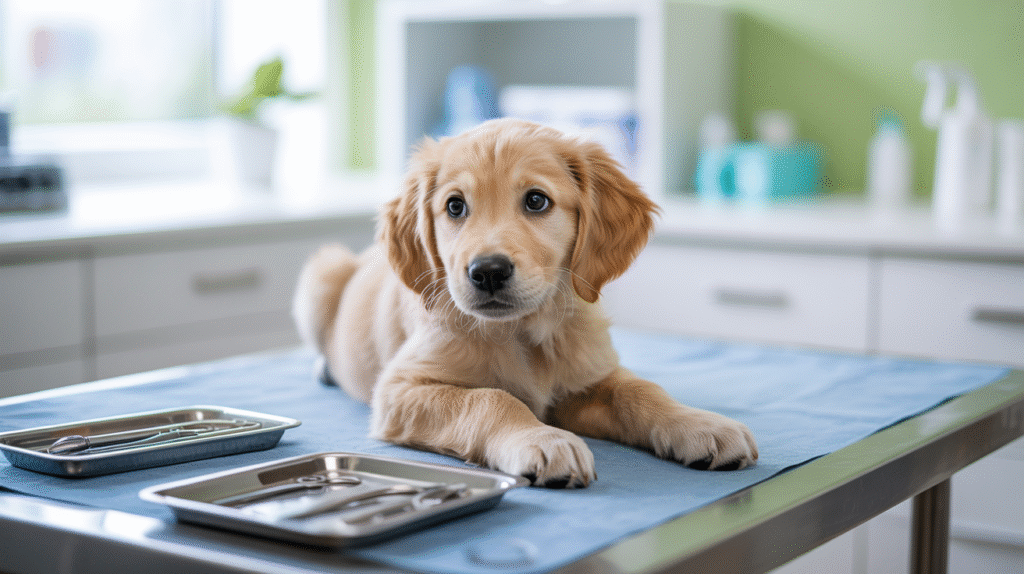
Why This Works: Hot spots (acute moist dermatitis) are one of the most common complications of seasonal allergies.
They start when your dog scratches, licks, or chews at irritated skin, creating a wound that quickly becomes infected with bacteria.
What begins as a small irritated area can become a painful, oozing wound within hours. Quick intervention prevents minor problems from becoming major veterinary emergencies.
Understanding Hot Spots:
What they look like:
- Red, moist, weeping lesions
- Hair loss in the affected area
- Circular or irregular shape
- Extremely painful to touch
- Often smell bad due to bacterial infection
- Can appear overnight and spread rapidly
Common locations:
- Behind ears
- Base of tail
- Hips and thighs
- Chest and flanks
- Under matted fur or around skin folds
Why allergic dogs get them: Constant scratching and licking damages the skin barrier, allowing bacteria (usually Staphylococcus) to invade and multiply rapidly in the warm, moist environment.
Step-by-Step Hot Spot Treatment:
At-Home Treatment (for small, early hot spots):
- Gently clip the hair around the affected area. Use blunt-end scissors or electric clippers with a guard. Create at least a 1-inch border around the hot spot. This allows air circulation and makes treatment easier.
- Clean the area thoroughly:
- Use warm water and gentle antiseptic (chlorhexidine or diluted betadine)
- Gently pat dry—don’t rub
- Avoid harsh chemicals, alcohol, or hydrogen peroxide which can delay healing
- Apply a topical treatment:
- Veterinary hot spot spray (with hydrocortisone and antibacterial)
- Chlorhexidine or betadine spray
- Antibiotic ointment (non-prescription like Neosporin, small amounts only if your dog won’t lick it)
- Prevent licking and chewing:
- Use an Elizabethan collar (cone)
- Try an inflatable collar or recovery suit
- Apply bitter spray around (not on) the wound
- Keep the area dry. Moisture makes hot spots worse. Don’t cover with bandages unless directed by your vet.
- Clean and treat 2-3 times daily until healed (typically 5-7 days for minor hot spots).
- Monitor closely. If the hot spot grows, doesn’t improve within 24-48 hours, or your dog seems unwell, see your vet.
When to See the Vet Immediately:
- Hot spot is larger than 2-3 inches
- Multiple hot spots appear
- Hot spot is very deep or has thick discharge
- Located near eyes, ears, or genitals
- Your dog has a fever or seems systemically ill
- Home treatment doesn’t show improvement within 48 hours
- Hot spot returns within weeks of healing
Veterinary Treatment May Include:
- Oral antibiotics (usually 2-3 weeks)
- Anti-inflammatory medications (steroids or Apoquel)
- Pain relief (hot spots are very painful)
- Medicated shampoos
- Topical prescription medications
- Professional clipping and cleaning
- Testing to rule out underlying issues (if recurring)
Prevention Strategies:
- Address the root cause. Hot spots are symptoms of allergies, so managing allergies prevents hot spots.
- Keep your dog’s coat groomed:
- Regular brushing prevents matting
- Trim thick coats in warm weather
- Bathe regularly to prevent bacterial buildup
- Dry thoroughly after swimming or bathing. Pay special attention to ears, skin folds, and thick fur areas.
- Act quickly on scratching. At the first sign of excessive scratching or licking, investigate and treat the area.
- Consider a cone during high allergy season if your dog is prone to hot spots.
- Manage anxiety and boredom. Some dogs develop hot spots from stress-induced licking.
Recommended Products:
For Cleaning:
- Veterinary Formula Clinical Care Hot Spot & Itch Relief Medicated Spray
- Douxo Chlorhexidine PS Pads
- Pet MD Hydrocortisone Spray
For Protection:
- Soft E-collars (Kong Cloud, Comfy Cone)
- Inflatable collars (requires supervision)
- Medical pet shirts or recovery suits
- Bitter spray deterrents
For Healing:
- Vetericyn Plus Hot Spot Spray
- Sulfodene Hot Spot & Itch Relief treatments
- Zymox Topical Cream (antimicrobial)
Expected Timeline:
- Days 1-2: Hot spot may look worse as infection drains
- Days 3-4: Should see reduced redness and weeping
- Days 5-7: Drying, scabbing, and healing begins
- Days 7-14: Hair begins regrowing
- Full healing: 2-3 weeks typically
Troubleshooting:
“My dog won’t leave the hot spot alone even with a cone.”
- Ensure the cone is the right size (should extend past nose)
- Try a different style (inflatable, soft cone, surgical suit)
- Ask your vet about anti-anxiety medication if licking is compulsive
- Apply bitter spray deterrent around the area
“The hot spot keeps coming back in the same place.”
- There may be an underlying issue (contact allergy, skin fold, trapped moisture)
- Your vet may need to do additional testing
- Some dogs need long-term preventive medication during allergy season
“Home treatment isn’t working.”
- Don’t wait too long—see your vet
- You may need prescription antibiotics
- Some hot spots have deeper infections requiring systemic treatment
Tip 7: Consult Your Vet About Safe Allergy Medications
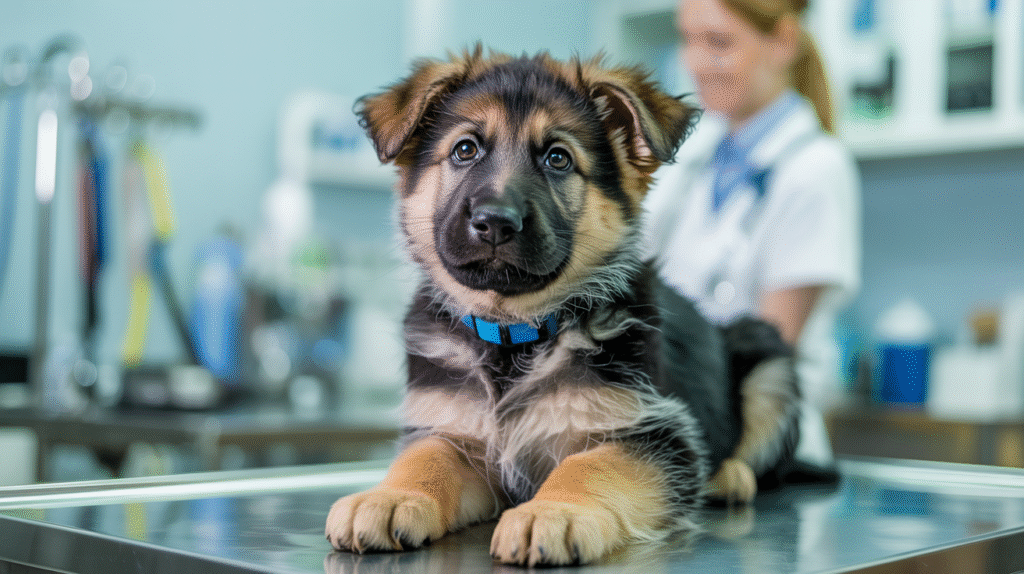
Why This Works: While environmental management and supportive care are essential, sometimes they’re not enough.
Seasonal allergies can be severe enough that they significantly impact your dog’s quality of life and even lead to secondary infections and complications.
Working with your veterinarian to find the right medication can provide life-changing relief for your dog.
Understanding Your Options:
Modern veterinary medicine offers many safe, effective allergy medications. The key is finding the right option for your dog’s specific situation.
Antihistamines:
How they work: Block histamine receptors, reducing allergic response.
Common options:
- Benadryl (Diphenhydramine): 1 mg per pound, 2-3 times daily
- Zyrtec (Cetirizine): 0.5 mg per pound, once daily
- Claritin (Loratadine): 0.5 mg per pound, once daily
- Chlorpheniramine: 4-12 mg per dog, 2-3 times daily
Pros:
- Relatively inexpensive
- Generally safe for long-term use
- Can help with mild to moderate allergies
- Easily accessible
Cons:
- Only effective in about 30% of dogs
- Can cause drowsiness
- Need consistent dosing
- Don’t work for severe allergies
Important: Always verify with your vet before giving any human medication. Some antihistamines contain decongestants or other ingredients toxic to dogs.
Apoquel (Oclacitinib):
How it works: Blocks specific enzymes involved in the itch response, providing relief within hours.
Dosing: Prescription only, typically 0.4-0.6 mg/kg twice daily for 14 days, then once daily.
Pros:
- Works quickly (within 4 hours)
- Very effective for most dogs
- Can be used short-term or long-term
- Minimal side effects for most dogs
- Doesn’t have the downsides of steroids
Cons:
- Expensive ($50-$150/month depending on dog size)
- Prescription only
- Not for dogs under 1 year old
- Can suppress immune system (avoid with infections)
- Long-term safety data still being collected
Cytopoint (Lokivetmab):
How it works: Monoclonal antibody injection that neutralizes the protein that signals itch. Given as an injection every 4-8 weeks.
Pros:
- Extremely effective for most dogs
- Long-lasting (one injection = 4-8 weeks relief)
- Very few side effects
- Doesn’t suppress immune system like steroids
- Works well for dogs who won’t take pills
Cons:
- Expensive ($50-$200 per injection depending on dog size)
- Requires vet visit for injection
- Doesn’t work for about 20% of dogs
- Takes 24-48 hours to see full effect
Corticosteroids (Prednisone, Dexamethasone):
How they work: Powerful anti-inflammatory medications that suppress the immune response.
Pros:
- Very effective
- Fast-acting
- Inexpensive
- Well-studied with predictable effects
Cons:
- Significant side effects with long-term use (increased thirst/urination, appetite, weight gain, liver changes, immune suppression)
- Only recommended for short-term use or severe cases
- Requires blood work monitoring for long-term use
- Shouldn’t be stopped suddenly
Use: Generally reserved for severe flare-ups or when other medications aren’t effective. Your vet will use the lowest effective dose for the shortest time possible.
Atopica (Cyclosporine):
How it works: Modifies immune response to reduce allergic reactions.
Pros:
- Effective for moderate to severe allergies
- Can be used long-term
- Good option when other medications don’t work
Cons:
- Very expensive
- Takes 4-6 weeks to see full effect
- Potential digestive side effects
- Requires monitoring
Immunotherapy (Allergy Shots):
How it works: Gradually desensitizes your dog to specific allergens through regular injections of small amounts of the allergen.
Process:
- Allergy testing to identify specific triggers
- Custom vaccine created for your dog
- Regular injections (starting frequently, then monthly)
- Treatment continues for 6 months to 1 year before assessing effectiveness
Pros:
- Addresses the root cause, not just symptoms
- Can provide lasting relief or cure
- Effective in 60-70% of dogs
- Reduces need for other medications long-term
Cons:
- Expensive upfront ($300-$1000+ for testing and first vaccines)
- Requires long-term commitment (injections for life, though less frequent over time)
- Takes 6-12 months to see results
- Doesn’t work for all dogs
- Requires regular vet visits initially
Working With Your Veterinarian:
Questions to Ask:
- “What medication do you recommend for my dog’s specific allergy severity?”
- “What are the potential side effects and how do we monitor for them?”
- “How long before we see improvement?”
- “What’s the long-term plan—seasonal use or year-round?”
- “Are there any drug interactions with my dog’s current medications?”
- “What’s the cost, and are there generic or less expensive alternatives?”
- “What should I do if the medication doesn’t work?”
- “Does my dog need blood work before or during treatment?”
What to Tell Your Vet:
- Complete symptom list (what, when, where, how severe)
- When symptoms started and any patterns you’ve noticed
- What you’ve already tried and results
- Your dog’s complete medical history
- Current medications and supplements
- Any budget constraints (so they can suggest appropriate options)
Expected Timeline:
- Antihistamines: 3-7 days to assess effectiveness
- Apoquel: Works within hours; assess at 2 weeks
- Cytopoint: Full effect at 48 hours; lasts 4-8 weeks
- Steroids: Works within hours; short-term use only
- Atopica: 4-6 weeks to full effectiveness
- Immunotherapy: 6-12 months for full assessment
Cost Considerations:
Budget-Friendly:
- Antihistamines: $10-$30/month
- Generic steroids: $15-$40/month
Mid-Range:
- Apoquel: $50-$100/month (varies by dog size)
Higher Investment:
- Cytopoint: $200-$800/season (depending on frequency needed)
- Immunotherapy: $300-$600/year after initial investment
Troubleshooting:
“The medication my vet prescribed isn’t working.”
- Give it enough time (most need 2-4 weeks minimum)
- Ensure you’re giving correct dose at correct times
- Consider that environmental management needs to happen alongside medication
- Discuss alternative options with your vet
“I can’t afford the recommended medication.”
- Be honest with your vet about budget
- Ask about generic alternatives
- Consider Care Credit or pet insurance
- Try starting with less expensive antihistamines
- Some drug manufacturers offer coupons or assistance programs
“My dog has side effects from allergy medication.”
- Contact your vet immediately
- Don’t stop medication suddenly (especially steroids)
- Ask about dose adjustment or alternative medications
- Some side effects improve over time; others require medication change
Prevention Strategies: Creating an Allergy-Friendly Lifestyle
Beyond treating active symptoms, you can create an environment and routine that minimizes allergy flare-ups.
Home Environment Modifications:
- Flooring: Hard floors (wood, tile, laminate) are far superior to carpet for allergic dogs. If you have carpet:
- Vacuum with HEPA filter 2-3 times weekly
- Steam clean monthly during allergy season
- Use allergen-neutralizing sprays
- Bedding:
- Wash dog beds weekly in hot water
- Choose waterproof, wipeable covers
- Place beds away from windows where pollen enters
- Consider allergen-barrier covers
- Humidity control:
- Maintain 30-50% humidity
- Use dehumidifiers if needed to prevent mold
- Clean humidifiers/dehumidifiers regularly
- Declutter:
- Less stuff = fewer surfaces collecting allergens
- Remove heavy drapes that trap dust
- Minimize upholstered furniture
Seasonal Grooming Adjustments:
- Pre-allergy season preparation:
- Schedule professional grooming before allergy season hits
- Consider a shorter summer cut for long-haired breeds
- Address any skin issues before they worsen
- During allergy season:
- Increase brushing frequency (daily)
- Weekly bathing with appropriate shampoo
- Keep ears clean and dry
- Trim fur between paw pads where allergens collect
- After allergy season:
- Address any damage (dry skin, hot spots)
- Return to normal grooming schedule
- Prepare for next season
Yard Care for Allergic Dogs:
- Lawn maintenance:
- Keep grass short (hire a lawn service)
- Water in evening to reduce morning pollen release
- Remove weeds before they flower
- Plant selection:
- Avoid high-allergen plants in your yard
- Choose low-pollen landscaping options
- Create hardscaping areas (patios, gravel paths)
- Outdoor zones:
- Designate low-allergen potty area
- Create shaded areas that pollen doesn’t penetrate as easily
- Regular yard cleanup to remove dead leaves and organic debris
Diet and Nutrition:
While food doesn’t cause seasonal allergies, nutrition supports skin health:
- High-quality, complete diet with appropriate protein and fatty acids
- Omega-3 supplementation as discussed earlier
- Probiotics may help regulate immune response
- Avoid food allergens if your dog has both food and seasonal allergies
Routine During Allergy Season:
Create a consistent daily routine:
Morning:
- Check pollen count
- Quick potty break only if high pollen
- Wipe paws upon returning
Midday:
- Indoor enrichment activities
- Training sessions
- Puzzle toys
Evening:
- Longer walk during lower pollen hours
- Full wipe-down after returning
- Any prescribed medications given with dinner
Before Bed:
- Final potty break
- Paw/coat wipe
- Check for any skin irritation
- Air purifier running in sleeping area
Frequently Asked Questions
Can dog allergies get worse over time?
Yes, unfortunately, environmental allergies often worsen with age. Dogs typically develop allergies between 1-3 years old, and symptoms may intensify with each passing season. Additionally, the allergy “season” may lengthen—a dog who once reacted only to spring pollen may eventually react to spring, summer, and fall allergens. The good news is that with proper management, you can keep symptoms controlled even as allergies progress. Some dogs also benefit from immunotherapy, which can actually improve or cure allergies over time.
Is it safe to give human allergy medication to dogs?
Some human allergy medications are safe for dogs, but you must NEVER give any medication without consulting your veterinarian first. Safe options (with vet approval and proper dosing) include:
- Benadryl (diphenhydramine)
- Zyrtec (cetirizine)
- Claritin (loratadine)
NEVER give:
- Combination cold/allergy medications containing decongestants (dangerous for dogs)
- Medications containing xylitol
- Extended-release formulas (difficult to dose correctly)
Always verify the exact product with your vet, as formulations vary and some contain toxic ingredients.
How do I know if symptoms are allergies or something else?
Seasonal allergies typically present with:
- Symptoms that appear or worsen during specific seasons
- Primarily skin-related symptoms (itching, redness, hot spots)
- Symptoms that improve with allergy medications or environmental changes
- No other systemic signs of illness
See your vet if your dog has:
- Symptoms that persist year-round (may be food allergies or other conditions)
- Digestive issues, vomiting, or diarrhea (more likely food-related)
- Difficulty breathing, coughing, or wheezing (respiratory issue)
- Fever, lethargy, or loss of appetite (infection or other illness)
- Symptoms that don’t respond to allergy treatment
Your vet can perform allergy testing, rule out other conditions, and create a targeted treatment plan.
Are some dog breeds more prone to seasonal allergies?
Yes, certain breeds are genetically predisposed to allergies:
High-risk breeds:
- Golden Retrievers
- Labrador Retrievers
- German Shepherds
- Bulldogs (English, French, American)
- Boxers
- Boston Terriers
- Dalmations
- Irish Setters
- West Highland White Terriers
- Wire Fox Terriers
- Cocker Spaniels
- Shar Peis
Breed-related factors:
- Dogs with skin folds (Bulldogs, Shar Peis) often have worse symptoms
- White dogs may show redness more obviously
- Dogs with lots of fur between toe pads accumulate more allergens
However, any dog of any breed can develop seasonal allergies. If you have a high-risk breed puppy, discuss preventive strategies with your vet.
Can I cure my dog’s allergies or will they need treatment forever?
There’s no quick cure for seasonal allergies, but outcomes vary:
Managing (not curing) allergies: Most dogs require some level of ongoing management during allergy seasons for life. This might mean:
- Environmental controls (paw wiping, air purifiers)
- Seasonal medications
- Regular bathing and grooming
Potential for improvement: Immunotherapy (allergy shots) can provide lasting improvement or even cure allergies in 60-70% of dogs over 1-3 years of treatment. This is the only option that addresses the root cause rather than just symptoms.
Natural improvement: Rarely, some dogs’ allergies improve as they age, though the opposite (worsening) is more common.
The goal: Even without a cure, most dogs with allergies can live comfortable, happy lives with proper management. The key is finding the right combination of environmental control, supportive care, and medications.
When to See the Vet
While many allergy symptoms can be managed at home, certain situations require professional veterinary care.
See Your Vet Soon (Within a Few Days) If:
- This is the first time your dog is showing allergy symptoms (need diagnosis)
- Symptoms are moderate and not responding to home care within 7-10 days
- You notice recurring ear infections
- Your dog has developed hot spots larger than a quarter
- Skin is persistently red and inflamed
- You want to discuss medication options or allergy testing
- Your dog seems generally uncomfortable despite your efforts
See Your Vet Immediately (Same Day or Emergency) If:
- Difficulty breathing, wheezing, or choking (potential allergic reaction/anaphylaxis)
- Severe facial swelling especially around eyes, muzzle, or throat
- Hives covering large portions of the body
- Vomiting and diarrhea in addition to skin symptoms
- Lethargy, weakness, or collapse
- High fever (over 103°F/39.4°C)
- Open wounds or bleeding from excessive scratching
- Signs of infection: foul odor, thick discharge, severe pain
- Eye problems: swelling, discharge, pawing at eyes, redness
- Suspected poisoning or toxic exposure
Signs of Secondary Infection Requiring Treatment:
- Pustules (pimple-like bumps) on skin
- Thick yellow, green, or bloody discharge
- Foul odor from skin or ears
- Severe pain when touched
- Spreading redness
- Swollen lymph nodes
- Greasy or crusty skin
What to Bring to Your Vet Appointment:
- Written symptom timeline: When did symptoms start, what have you observed, what patterns have you noticed?
- Photos or videos: Document symptoms, especially if they come and go
- List of everything you’ve tried: Products, medications, environmental changes
- Current medications and supplements: Bring bottles or list with doses
- Questions you want answered: Write them down so you don’t forget
- Your budget: Be upfront so your vet can recommend appropriate options
What Your Vet Might Do:
- Physical examination focusing on skin, ears, and overall health
- Skin cytology (looking at skin cells under microscope for infection)
- Skin scraping (checking for parasites like mites)
- Allergy testing (blood or intradermal testing to identify specific allergens)
- Culture (if infection suspected)
- Blood work (to rule out other conditions or monitor medication effects)
Don’t delay seeking help if you’re concerned. Early intervention often prevents more serious complications and expensive treatments down the line.
Conclusion: Your Dog Deserves Relief
Watching your beloved dog suffer through allergy season is heartbreaking, but you now have a comprehensive toolkit to help them find relief. Seasonal allergies may be a chronic condition, but they absolutely don’t have to control your dog’s life or ruin your time together.
Remember these key takeaways:
- Consistency is crucial. Allergy management works best when you implement multiple strategies consistently, not just when symptoms are severe.
- Start before symptoms peak. If you know your dog suffers in spring, start your management routine in late winter. Prevention is easier than treatment.
- Every dog is different. What works wonderfully for one dog may not work for another. Be prepared to experiment and adjust your approach.
- Partner with your vet. Home care is essential, but work with your veterinarian to create a comprehensive plan, especially if symptoms are moderate to severe.
- Small changes add up. Even if each individual tip provides only modest improvement, combining multiple strategies creates significant relief.
- Be patient. Many allergy management strategies take 2-4 weeks to show full benefits. Don’t give up too soon.
Your Action Plan:
This Week:
- Set up your post-walk wipe-down station
- Purchase hypoallergenic shampoo for weekly baths
- Start omega-3 supplementation
- Research air purifiers for your home
- Schedule a vet appointment if needed
This Month:
- Establish consistent bathing and grooming routine
- Implement strategic outdoor timing
- Monitor for early signs of hot spots
- Track which interventions help most
This Season:
- Continue all management strategies consistently
- Work with your vet to optimize medication if needed
- Document what works for next year’s allergy season
- Celebrate improvements, even small ones!
Looking Ahead:
- Prepare in advance for next allergy season
- Consider allergy testing and immunotherapy for severe cases
- Adjust your home environment for long-term allergen reduction
- Build a predictable routine that keeps symptoms controlled
Your dog depends on you to recognize their discomfort and take action. With the seven tips outlined in this guide—from simple paw wiping to working with your vet on medications—you have everything you need to significantly improve your dog’s quality of life during allergy season.
We Want to Hear From You!
What allergy management strategies have worked best for your dog? What challenges are you still facing? Share your experiences in the comments below—your insights might help another desperate pet parent find relief for their itchy pup!
Found this guide helpful? Pin it to your “Dog Health” or “Pet Care” board so you can reference it when allergy season hits. Share it with friends whose dogs are suffering through seasonal allergies. Together, we can help more dogs live comfortably despite their allergies!
Continue Your Dog Health Journey:
- 10 Signs Your Dog Needs a Vet Visit Immediately
- Complete Guide to Dog Grooming at Home
- Understanding Common Skin Conditions in Dogs
- Best Dog Foods for Dogs with Allergies
- How to Give Your Dog Medication: A Stress-Free Guide
Remember: Allergies are manageable. With the right approach, your dog can enjoy every season comfortably. Here’s to less scratching, fewer hot spots, and many more happy, healthy days together!
Disclaimer: This article provides general information about managing seasonal allergies in dogs and is not a substitute for professional veterinary advice. Every dog is unique, and treatment should be tailored to individual needs. Always consult with your veterinarian before starting new treatments, medications, or supplements. If your dog shows signs of severe allergic reaction or distress, seek emergency veterinary care immediately.
SOURCES & FURTHER READING
- American Veterinary Medical Association (AVMA): https://www.avma.org
- PetMD: “Dog Seasonal Allergies” https://www.petmd.com/dog/seasonal-allergies
- VCA Hospitals: “Allergies in Dogs” https://vcahospitals.com/know-your-pet/allergies-in-dogs
- ASPCA: “Dog Allergies and Their Management” https://www.aspca.org/pet-care/dog-care/dog-allergies

